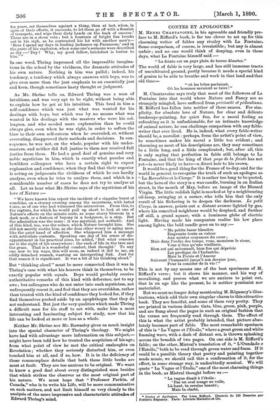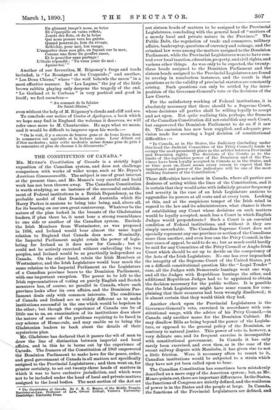COIsITES ET APOLOG1TES.* M. HENRI CHANTAVOINE, in his agreeable and
friendly pre- face to M. Riffard's book, is far too clever to set up for this charming writer of fables any rivalry with La Fontaine.- Some comparison, of course, is irresistible; but any is almost unfair; and no one would think of denying, even in these days, what La Fontaine himself said :—
"La feinte eat un pays plein de terres desertes."
The world of fable is very large, and has still immense tracts- of uncultivated ground, partly because it needs a special kind.
of genius to be able to breathe and work in that land and that old time—
"sit lea hetes parlaient, Oh lea hommes savaient se taire 1"
M. Chantavoine says truly that most of the followers of La Fontaine into that world where Nature and Fancy are so strangely mingled, have suffered from preciosite et pedantisme. M. Riffard has fallen into neither of these snares. For sim- plicity, for absolute love of Nature, for clear and delicate- landscape-painting, for quiet fun, for a moral feeling as refreshing as it is unfashionable, for an intimate knowledge. of animal nature, he can challenge comparison with any fable- writer that ever lived. He is, indeed, what every fable-writer should be, a moralist : perhaps, from the artist's point of view,. he sometimes makes his moral a little too evident ; and charming as most of his descriptions axe, they may sometimes- be a little long, and a little complicated; but, after all, this is only saying that perfection in fable still belongs to La Fontaine, and that the king of that pays de la feinte has not
yet—is never likely to have—a direct heir to his crown.
It would be a good thing for the France of to-day, and for the-
world in general, to recognise the truth of such an apologne as " La Reverbere et le Cierge." It is rather too long to be quoted, but the hero of the story is a wax candle, burning in an Italian. street, in the month of May, before an image of the Blessed Virgin. The little reddish light is mocked at by a neighbouring oil-lamp, swinging at a corner, who tells him that the only result of his flickering is to deepen the darkness. Le petit Cierge, in answer, points out a distant avenue lighted by gas,
where his conceited neighbour would be despised, and further off still, a grand square, with a luminous globe of electric light. Having made his companion realise his low place- among lights, the bold candle goes on to say :— " Ma petite lueur bleuatre Emprunte touts ea valour
Aux salutes croyances du caeur ;
Mais dans l'ordre des temps, vous, monsieur le rietu., Vous n'etes qu'une vieillerie. Bien sot qui meconnait, hien fou qui deprecie Les procliges de PIndustrie. Male In Poesie et l'Amour Suivront l'humanite jusqu'k son dernier jour, Pour is consoler de is vie !"
This is not by any means one of the best specimens of TeL Riffard's verse; but it shows his manner, and his way of moralising, and proves what we are anxious to point out, that in an age like the present, he is neither pessimist nor
materialist.
But we must no longer delay mentioning M. Regamey's illus- trations, which add their own singular charm to this attractive book. They axe fanciful, and some of them very pretty. They are printed in various delicate tints, blue, green, pink, purple,. and are flung about the pages in such an original fashion that
the verses are frequently read through them. The effect of this is what the artist probably intended, that picture abso- lutely becomes part of fable. The most remarkable specimen_ of this is "La Vague et PEtoile," where a great green and white foaming wave, with a dash of distant sea, is thrown splashing across the breadth of two pages. On one side is M. Riffard's fable; on the other, Mistral's translation of it, " L'Oundado e l'Estello," both to be read through green water and foam. If it could be a possible theory that poetry and painting together made music, we should call this a confirmation of it, for the- effect, in some strange way, is undoubtedly musical. We will quote "La Vague et l'Etoile," one of the most charming things. in the book, as Mistral thought before us :— "La vague disait Petoile : 'Pas un seul nuage ne voile, Lk-haut, ta sereine beaute Mats ta clarte, • Conte: at Apologues. Par Ldon Riffard. Illastrds de 150 Desseins par Ereddric Regamey. Paris: Libreria Hachette et Cria.
En glissant jusqu'it nous, se brise Et s'eparpille en mins reflets, Jottets des (lots, et de la brise Qui nous pousse vers lee galets. Quand pourrai-je, loin du rivage, Reilechir, pour moi, ton image, L'emporter dans sees pile, en fuyant stir la mer, Comme une flour du gouffre amer, Et le posseder sans partage !
L'etoile repondit Tit veux jouir de moi Apaise-toi.' "
Another of our favourites, M. Regamey's frogs and toads included, is "Ike Rossignol et lee Crapauds ;" and another, "Les Dean Chiens," where "the wolf behowls the moon" in a most effective manner. In "Lea Lapins," the joy of the little brown rabbits playing only deepens the tragedy of the end. "Le Goeland et le Corbeau " is very poetical and good in itself; we feel ourselves—
"Au sommet de la falaise De Saint-Blaise," even without the help of M. Regamey's clouds and cliff and sea.
To conclude our notice of Conies et Apologues, a book which we hope may find in England the welcome it deserves, we will refer once more to M. Chantavoine. He says what we mean, and it would be difficult to improve upon his words :— " On le voit, II y a encore de braves gene et de bons livres dont le commerce eat agreable et la lecture same. Leur defaut est d'être modestes ; mais cette modestie mime donne plus de prix a in rencontre et plus de charme a. la decouverte."







































 Previous page
Previous page